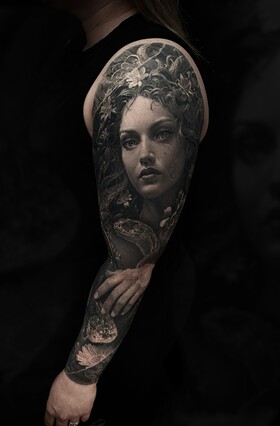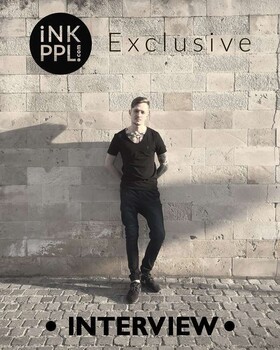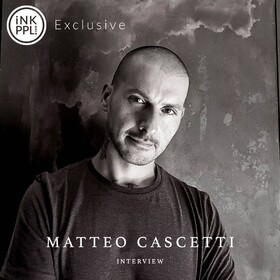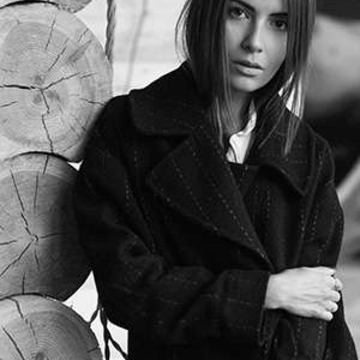Kirill Antik — a tattoo artist whose microscopic portraits and jewelry-fine lines are known in Russia, Germany, France and the UAE. He was among the first to introduce gold accents into micro-realism and proved that highly detailed pieces can heal just as «cleanly» as classic ones. In this exclusive interview for iNKPPL, Kirill talks about the rebellion that brought him to tattooing, the rules that let him cover an entire back in a single ten-hour session and why today he looks for inspiration not on social media but within himself.
How did you get into tattooing and what pushed you to choose this particular path?
— I probably came to tattooing through protest against society. In my youth I listened to punk rock and other «extreme» heavy-music genres, so my choice of profession landed on an equally rebellious form of visual art that inspired me. Back then it wasn’t wholly conscious: I made the decision at quite an early age and without support from the older generation. Later, once I was more mature, I gained awareness and understood why I needed all this. I entered the profession on my own, without a mentor, and went a long road that today, under current conditions, could have been shorter. Of course, along the way I took individual master classes with well-known artists—that’s how I saved time on the path to my goal.
.jpg)
Which artistic or cultural influences shaped your style in micro-realism and fine-line?
— I think fine-line and micro-realism are born first of the artist’s character, not external influences. Even when I’d worked only a couple of years, artists with twenty years’ experience were amazed by my lines. It was the same when I began «dialing up» detail in micro-realism: people watched almost spellbound. Everyone has an inner leaning: someone perfectly lays down an old-school outline, while someone else can paint every eyelash on a face the size of a fingernail. So it’s vital to find and understand yourself within tattoo styles.
.jpg)
How do you approach creating a tattoo so it harmonizes with the client’s body and personality?
— I always create an individual design. First I ask what the person wants to see, ask for sample pieces to catch the nuances, and sometimes discuss symbolism. Then I carefully study the anatomy of the area—that’s the base of the future composition. Only after that do I select references and build the final sketch. That’s how I harmonize the idea with the client’s body and personality.
What themes or images most often appear in your work and why do they resonate with you?
— In 90 % of cases I start from the client’s request—my schedule leaves little time for personal «want-to-dos». But themes I gladly return to are Greek mythology, film and literary characters, mythical creatures—pegasi, manticores, etc.—plus portraits of people and pets. I dream of a series on Russian fairy tales and classic literature.

What technical challenges do you face working in micro-realism, and how do you overcome them?
— Micro-realism is tougher than classic realism: it takes many times more focus and precision; it’s like surgery in the art world. You need to apply the piece so that once healed it sparks delight, not memes. Over years I’ve intuitively honed an approach: roughly one client in forty comes for a touch-up—and even then, not always.
.jpg)
How do you adapt your approach when working with clients in different countries—for instance, Germany, France and Russia?
— I build waiting lists months in advance. Before traveling, say, to Germany, I contact people on the list, take a deposit and plan the trip. Usually that’s a couple of months out so clients have time to budget.
Which achievements in your career do you consider most important?
— I’m not chasing accolades—the process itself matters to me. But there are things I’m proud of. I was among the first to bring gold elements into micro-realism and saw other artists pick up the idea. Another feat is speed: once we covered an entire back in a single ten-hour session. I don’t plan to repeat it—it was hard on the client—but I know it’s technically possible.
.jpg)
How has taking part in international tattoo conventions influenced your growth as an artist?
— Every convention spurs me to do even better work: you look at colleagues and want to outdo yourself.
Are there client reactions that especially stuck with you?
— The strongest reactions aren’t on social media but in the studio, when someone looks in the mirror at their new tattoo and cries with happiness (smiles). Photos of loved ones, portraits of pets, places tied to dear people—anything that sparks genuine emotion—sticks with me forever.
.jpg)
How do you keep a high level of quality and sterility in your work?
— I follow four simple rules:
-
Anything that can be sterilized must be sterile.
-
Anything that can’t be sterilized must be single-use.
-
Anything that needs solid color must get solid color.
-
Anything that doesn’t need heavy packing is applied as delicately as possible.
What new techniques or approaches have you introduced over recent years?
— This past year I’ve posted almost nothing—I paused social media. I’m prepping new ideas filtered through myself. Lately I’ve seriously upped my speed—a forearm in micro-realism can take me 3–4 hours (sometimes longer on tricky skin). It used to take 8–10.
.jpg)
How do you keep evolving and learning in a fast-changing tattoo industry?
— I observe, experiment and try non-standard moves. Right now I’m looking inside myself more than at Instagram—searching for new answers.
Which projects or tattoos have been the toughest or, conversely, most inspiring for you?
— We’re finishing a sleeve inspired by “Jíbaro”—a long-runner since 2022. Back then I lacked color experience, but now everything’s «dialed in». Bits are on Instagram, but the full sleeve isn’t out yet. One session remains, then we can photograph it. It’s both hard and invigorating: story line, geometry, color realism—all the stuff I love.
How do you build trust with clients, especially on large projects?
— More often than not people arrive already trusting—thanks to your readers for that (smiles). If trust is lacking, I explain every stage in detail, share my experience, and the person sees their project is in safe hands.
What brings you the greatest pleasure in your work?
— The process itself. When you draw on skin and literally feel the subject—there’s nothing like it. Oil paint doesn’t «grab» like that, but skin does.
.jpg)
How do you see your future development—in style, technique, maybe teaching or opening your own studio?
— First I want to fine-tune my style—that’s the foundation. Next step: a studio. After that, maybe teaching. But the core will always be tattooing, not business.
What advice would you give beginners just entering the profession?
— Choose your direction, take master classes, seek mentors, practice as much as you can. Study your mistakes and don’t fear them.
.jpg)
How do you create a unique design for every client? Do you have a specific ritual or approach?
— It all starts with conversation. A written brief rarely suffices. I ask questions, request examples to grasp the person’s character. Then I craft a design for that character and always show it to the client to make sure the sketch resonates. They’ll live with this piece many years—it has to make them happy.
Which tattoo-art trends strike you as most interesting or promising?
— Tough to say: it’s like gambling—nobody knows which way society will turn. Many factors influence trends, and pop culture is the biggest. I think much will stay, and old-school might become the new narrative: someone will breathe life into it because it’s a classic the mainstream half-forgot. Looking inside the global tattoo community, it’s clear that a «live» drawing will be prized even more since neural nets now spit out images in seconds. The «warm» handmade vibe will grow and artists with an academic base will be in higher demand than «AI toddlers» (smiles). So folks, learn your basics—and you’ll be fine!
.jpg)
How do you balance commercial commissions with creative experiments?
— I try to blend them: I pull commercial projects up to the level of creative experiments. Lately I do that less: if a client wants a «Viking wolf» I’ll do it, but I don’t post it as often. I’m planning a sketch series for those long tired of the wolf motif (smiles). More and more I lean into project-based work and take fewer conveyor-belt orders—I’m worn out «tattooing everything» and focused on evolving my own style.


.jpg)
.jpg)
.jpg)
.jpg)





Comments (4)